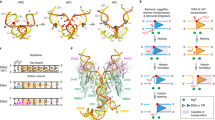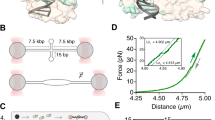Abstract
COMMUNICATIONS between distant sites on DNA often depend on the way in which the sites are connected1,2. For example, site-specific recombination catalysed by Tn3 resolvase is most efficient when the 114-base-pair res recombination sites are directly repeated in the same DNA molecule3. In vitro a supercoiled plasmid substrate containing two directly repeated res sites gives a resolution product in which the two recombinant circles are topologically linked as a simple (two-noded) catenane (Fig. la). Resolvase is highly selective in forming this product rather than unlinked circles or more complex catenanes. It does not catalyse recombination between sites on separate supercoiled molecules, or between inverted sites in the same supercoiled molecule3–5. Tn3 resolution removes four negative supercoils from the substrate, an energetically favourable change which may drive the reaction6: in relaxed or nicked circular substrates, resolution is incomplete and slower. Resolvase can catalyse fusion of the circles of a nicked or relaxed catenane, giving a single unknotted circular product6,7. The fusion is the precise topological reversal of resolution, introducing four negative supercoils into a relaxed catenane substrate6, and should therefore not proceed if the catenane is already negatively supercoiled. Here we study recombination between res sites in non-supercoiled DNA circles linked into simple catenanes. We used (+2) and (−2) catenanes, which differ only in the direction in which one circle is threaded through the other (Fig. 2a). Although stereoselectivity is a feature of enzyme catalysis, it is not obvious how resolvase can distinguish between these subtly different catenane diastereomers. A model for the intertwining of the res site DNA in the catalytically active complex4,7 predicts that only the (−2) catenane will recombine, giving unknotted and 4-noded knot circular products. We have confirmed this prediction for the Tn3 and Tn21 resolvases.
This is a preview of subscription content, access via your institution
Access options
Subscribe to this journal
Receive 51 print issues and online access
$199.00 per year
only $3.90 per issue
Buy this article
- Purchase on Springer Link
- Instant access to full article PDF
Prices may be subject to local taxes which are calculated during checkout
Similar content being viewed by others
References
Gellert, M. & Nash, H. A. Nature, 325, 401–404 (1987).
Wang, J. C. & Giaever, G. N. Science, 240, 300–304 (1988).
Hatfull, G. F. & Grindley, N. D. F. in Genetic Recombination (eds Kucherlapati, R. & Smith, G. R.) 357–396 (Am. Soc. Microbiol., Washington DC, 1988)
Stark, W. M., Boocock, M. R. & Sherratt, D. J. Trends Genet. 5, 304–309 (1989).
Reed, R. R. Cell 25, 713–719 (1981).
Stark, W. M., Sherratt, D. J. & Boocock, M. R. Cell 58, 779–790 (1989).
Boocock, M. R., Brown, J. L. & Sherratt, D. J. UCLA Symp molec. cell. Biol. 47, 703–718 (1987).
Wasserman, S. A. & Cozzarelli, N. R. Proc. natn. Acad. Sci. U.S.A. 82, 1079–1083 (1985).
Wasserman, S. A., Dungan, J. M. & Cozzarelli, N. R. Science 229, 171–174 (1985).
Stark, W. M., Grindley, N. D. F., Hatfull, G. F. & Boocock, M. R. EMBO J. 10, 3541–3548 (1991).
Benjamin, H. W. & Cozzarelli, N. R. J. biol. Chem. 165, 6441–6447 (1990).
Mizuuchi, K., Gellert, M., Weisberg, R. A. & Nash, H. A. J. molec. Biol. 141, 485–494 (1980).
Pollock, T. J. & Nash, H. A. J. molec. Biol. 170, 1–18 (1983).
Beatty, L. G., Babineau-Clary, D., Hogrefe, C. & Sadowski, P. D. J. molec. Biol. 188, 529–544 (1986).
Abremski, K. & Hoess, R. H. J. molec. Biol. 184, 211–220 (1985).
Boocock, M. R., Brown, J. L. & Sherratt, D. J. Biochem. Soc. Trans. 14, 214–216 (1986).
Parker, C. N. & Halford, S. E. Cell 66, 781–791 (1991).
Castell, S. E., Jordan, S. L. & Halford, S. E. Nucleic Acids Res. 14, 7213–7226 (1986).
Craigie, R. & Mizuuchi, K. Cell 45, 793–800 (1986).
Wasserman, S. A., White, J. H. & Cozzarelli, N. R. Nature 334, 448–450 (1988).
Author information
Authors and Affiliations
Rights and permissions
About this article
Cite this article
Stark, W., Parker, C., Halford, S. et al. Stereoselectivity of DNA catenane fusion by resolvase. Nature 368, 76–78 (1994). https://doi.org/10.1038/368076a0
Received:
Accepted:
Issue Date:
DOI: https://doi.org/10.1038/368076a0
Comments
By submitting a comment you agree to abide by our Terms and Community Guidelines. If you find something abusive or that does not comply with our terms or guidelines please flag it as inappropriate.



